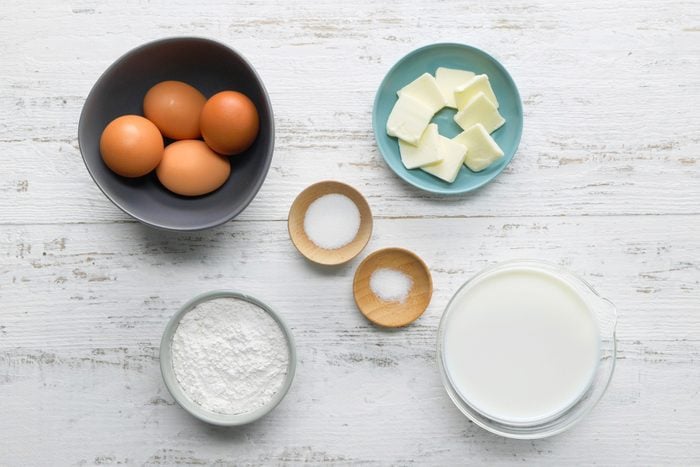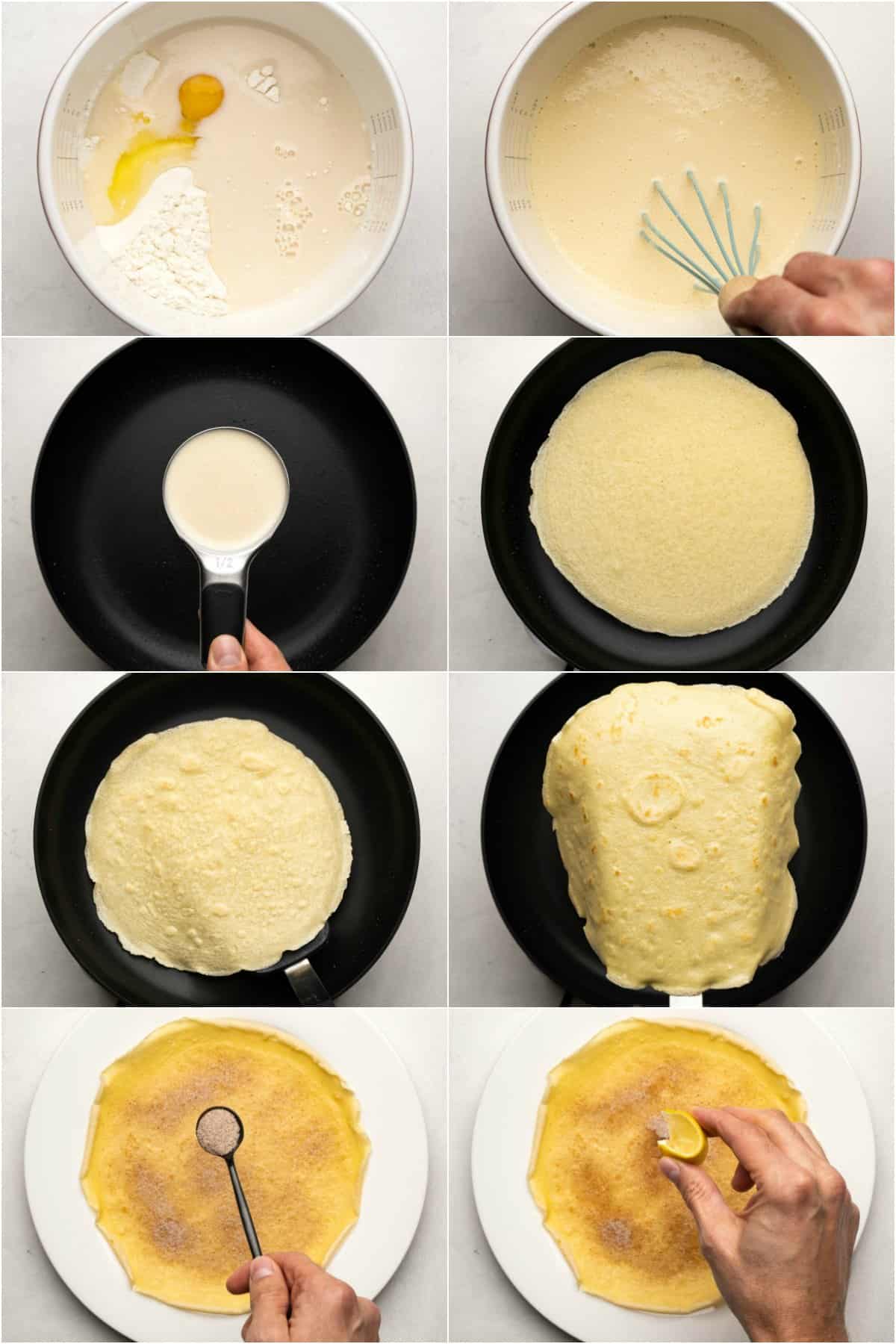Crepes are the French version of thin pancakes, but what sets them apart is their delicate, crisp texture when made just right. Unlike traditional pancakes, crepes are super thin, which allows them to achieve a beautiful crispiness when cooked properly. Whether you’re making them for breakfast, brunch, or dessert, crispy crepes are a versatile dish that can be filled with anything from Nutella to cheese. This guide provides you with crispy crepes recipe.
Ingredients for Crispy Crepes

The key to perfect crispy crepes starts with the right ingredients. Here’s what you’ll need:
Basic Ingredients:
- 1 cup of all-purpose flour
- 2 large eggs
- 1 cup of milk
- ½ cup of water
- ¼ teaspoon salt
- 2 tablespoons melted butter
Optional Add-ins for Flavor:
- 1 teaspoon vanilla extract (for sweet crepes)
- 1 tablespoon sugar (for added sweetness)
- Herbs like thyme or parsley (for savory crepes)
Tools You Need for Crepe Making
Before diving into the cooking process, make sure you have the right tools:
- A non-stick frying pan or crepe pan
- A flat spatula
- A whisk or blender to mix the batter
- Ladle for portioning the batter
Step-by-Step Guide to Making Crispy Crepes

Making crispy crepes at home is easy once you know the steps. Follow this detailed guide for perfectly thin and crispy crepes every time.
Step 1: Prepare the Crepe Batter
Mix the dry ingredients: In a large bowl, sift 1 cup of all-purpose flour and ¼ teaspoon of salt. This helps remove any lumps and ensures a smooth batter.
Whisk the eggs: In another bowl, beat 2 large eggs until fully mixed.
Combine eggs and flour: Slowly add the whisked eggs into the flour mixture. Stir continuously to prevent clumping.
Add liquids gradually: Slowly add 1 cup of milk and ½ cup of water to the mixture while whisking. This creates a thin, smooth batter without lumps.
Add melted butter: Stir in 2 tablespoons of melted butter. This helps the crepes cook evenly and adds to the crispy texture.
Rest the batter: Cover the batter and let it rest for at least 30 minutes. This allows the flour to absorb the liquid and results in more tender, crispy crepes.
Step 2: Heat the Pan
Choose the right pan: Use a non-stick frying pan or a crepe pan, ideally 8 to 10 inches in diameter.
Preheat the pan: Place the pan over medium-high heat. It should be hot enough that a drop of water sizzles on contact.
Grease the pan: Lightly grease the pan with butter or a small amount of oil. Use a paper towel to spread it evenly and avoid excess fat, which can prevent the crepes from crisping up.
Step 3: Cook the Crepes
Pour the batter: Use a ladle to pour about ¼ cup of batter into the center of the hot pan. Immediately tilt the pan in a circular motion to spread the batter evenly. The thinner the layer, the crispier the crepe will be.
Cook the first side: Let the crepe cook for 1-2 minutes. You’ll know it’s ready to flip when the edges start to lift and turn golden brown.
Flip the crepe: Use a flat spatula to gently loosen the edges and flip the crepe. Cook the second side for another 30 seconds to 1 minute, until golden and crispy.
Repeat the process: Continue the process with the remaining batter, greasing the pan lightly between each crepe if necessary.
Step 4: Serve the Crepes
Stack or serve individually: You can stack the cooked crepes with parchment paper between each one to keep them warm, or serve them immediately.
Add fillings: Fill the crepes with your choice of sweet or savory fillings (Nutella, berries, cheese, ham, etc.) and either fold them or roll them up.
Enjoy immediately: For the crispiest crepes, serve them right after cooking. Crepes tend to lose their crispiness as they cool, so eat them fresh off the pan!
Tips for perfectly crispy crepes

Getting crepes to be perfectly crispy takes some practice, but these bonus tips will help you achieve that golden-brown, delicate crisp every time. Follow these detailed tips to make your crepes consistently thin, light, and crispy.
Control the Batter Consistency
One of the most important factors in getting crispy crepes is the batter consistency. The batter should be thin, almost like heavy cream, so that it spreads easily and cooks quickly.
Thin out the batter if needed: If your batter feels too thick, add a small amount of water or milk to reach the right consistency. Be careful not to add too much at once—start with a tablespoon of liquid at a time.
Avoid a too-thick batter: A thick batter leads to thick crepes, which won’t crisp up as well. You want the batter to be thin enough that it coats the pan in a very fine layer when poured.
Smooth the batter: If your batter is lumpy, it will create uneven crepes. After mixing, let the batter rest for about 30 minutes. This allows any lumps to dissolve, giving you a smooth and light texture.
Don’t Over-Grease the Pan
Too much butter or oil can prevent the crepes from crisping up and leave them greasy or soggy.
Use minimal grease: When cooking the crepes, lightly grease the pan with a small amount of butter or oil. You can use a paper towel to wipe the pan between crepes, ensuring there’s just a thin coating of fat. Too much butter can also make the edges of the crepes overly brown without giving the desired crispiness.
Butter for flavor, oil for crispiness: Butter adds a great flavor to crepes, but it burns faster than oil. For best results, use butter for flavor and neutral oil (like vegetable or canola oil) to ensure the crepes cook evenly and crisp without burning.
Adjust the Heat for Optimal Crisping
Cooking crepes at the right temperature is key to getting that crispy edge without burning or overcooking.
Use medium-high heat: Set your stove to medium-high heat for a balance between crispiness and tenderness. Too high heat can cause the crepes to burn before they cook through, while too low heat will make them soft and pale instead of crispy.
Test the pan temperature: Before cooking your first crepe, test the heat by dropping a tiny bit of batter into the pan. It should start cooking immediately and form bubbles, but it shouldn’t brown too quickly. Adjust the heat if necessary.
Reheat the pan between batches: If you’re making multiple crepes, the pan might cool slightly between crepes. Make sure to reheat the pan to the proper temperature before pouring in each batch of batter.
Thin, Even Layer of Batter
A thin, even layer of batter is crucial for making crispy crepes.
Pour the batter quickly: As soon as you ladle the batter into the pan, quickly tilt and swirl the pan in a circular motion to spread the batter evenly across the bottom. You want the batter to cover the entire surface in a thin, uniform layer.
Work quickly: The batter starts cooking immediately, so if you don’t spread it fast enough, it can thicken in one area and prevent the crepe from being as thin and crispy as possible.
Avoid too much batter: Only use about ¼ cup of batter per crepe (depending on the size of your pan). Too much batter results in thicker crepes that won’t crisp up properly.
Flip at the Right Time
Timing your flips correctly ensures that the crepes cook evenly and stay crisp.
Look for the right signs: You’ll know the crepe is ready to flip when the edges start to lift and turn golden brown. The surface should also appear dry, and the crepe should move easily when you shake the pan gently.
Use a flat spatula: Gently slide a flat spatula under the edges to loosen the crepe. Be careful not to break it—flip it quickly but gently.
Cook briefly on the second side: The second side of the crepe usually cooks faster. It will only need about 30 seconds to 1 minute to get a light golden brown and crispy.
Let the Crepes Rest on a Wire Rack
To keep your crepes crispy after cooking, avoid stacking them directly on top of each other.
Use a wire rack: Place the crepes on a wire cooling rack in a single layer after cooking. This allows air to circulate around them and prevents steam from making them soggy.
Avoid covering immediately: If you cover the crepes with foil or stack them while they’re still hot, the trapped steam can soften them, reducing the crispiness.
Serve the Crepes Immediately
Crispy crepes are best enjoyed fresh, as they tend to soften as they sit.
Serve right away: For the crispiest texture, serve the crepes as soon as they’re off the pan. The longer they sit, the more they lose their crispness.
Keep them warm without losing crispiness: If you need to keep crepes warm while cooking more, place them in a warm oven (around 200°F) on a baking sheet. Don’t cover them too tightly, as the steam could soften them.

